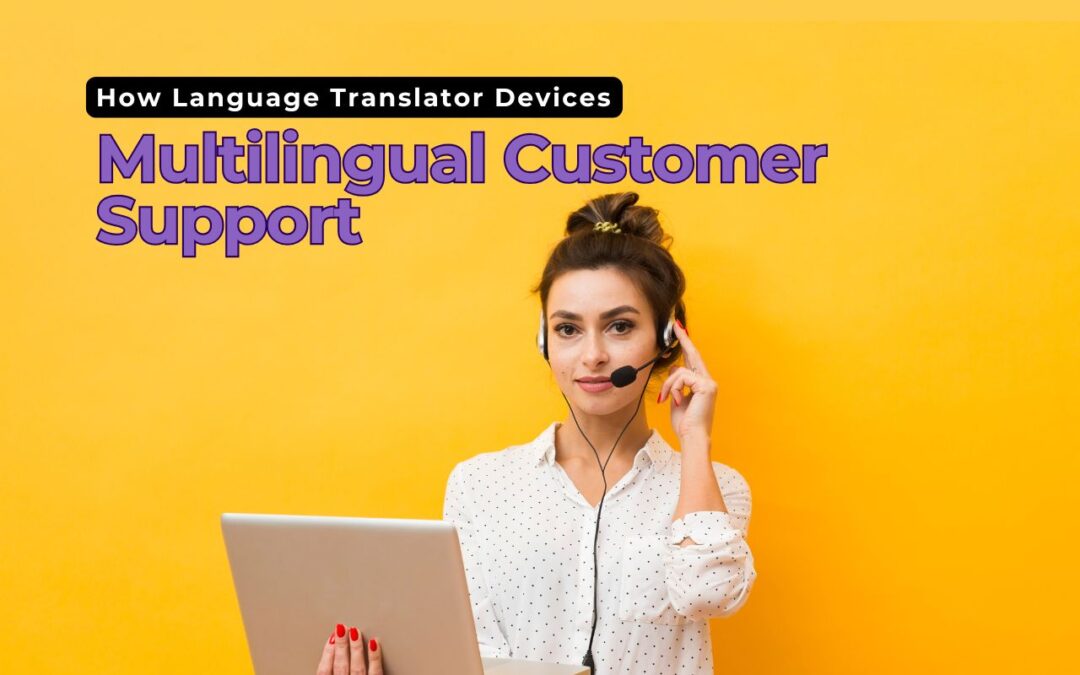In today’s increasingly globalized and digitally interconnected world, businesses are expected to communicate seamlessly across language barriers. Whether it’s a small e-commerce platform serving international customers or a multinational corporation operating in several countries, delivering exceptional customer support to people who speak different languages has become not just an advantage—but a necessity. Enter language translator devices—a revolutionary tool reshaping the landscape of multilingual customer support.
These intelligent devices are not just gadgets; they are enablers of inclusive service, cross-border efficiency, and brand loyalty. As companies expand their reach, these devices are proving instrumental in bridging the communication gap, empowering customer service representatives to provide real-time support, and ultimately enhancing customer satisfaction across diverse language groups.
In this article, we’ll delve deep into how language translator devices are enhancing multilingual customer support, why they are becoming essential for businesses of all sizes, the operational and strategic advantages they offer, and the future of this technology in service-driven industries.
The Need for Multilingual Customer Support
The foundation of good customer service lies in clear and effective communication. When customers feel understood, valued, and respected in their own language, their loyalty and satisfaction increase. Businesses, therefore, are faced with the challenge of offering support in multiple languages—a task that is neither easy nor inexpensive when done manually or via traditional translation services.
Whether it’s handling complaints, guiding users through product setup, or providing after-sales support, companies must overcome linguistic hurdles to stay competitive. Traditional methods like hiring multilingual agents or outsourcing support to different regions have limitations—cost, quality inconsistency, and time zone issues among them. Language translator devices are helping to fill these gaps, delivering fast, accurate, and cost-effective translation in real time.
What Are Language Translator Devices?
Language translator devices are electronic tools that translate spoken or written language from one language to another, often instantly. They can take various forms—handheld devices, wearables, or software-integrated solutions in mobile or desktop platforms. Their use is expanding beyond travelers and tourists to more strategic business functions, especially customer support.
These devices are powered by advanced speech recognition, natural language processing (NLP), and artificial intelligence (AI) technologies. They learn, adapt, and provide increasingly accurate translations over time, offering real-time, context-sensitive support that approximates human-level conversation.
Enhancing Frontline Customer Service
1. Real-Time Verbal Interaction
One of the primary applications of language translator devices in customer service is real-time verbal interaction. Customer service representatives can use these devices to instantly translate spoken language during a call or in-person interaction, allowing for fluent and uninterrupted dialogue with customers who speak different languages.
This is particularly valuable in retail stores, hotels, hospitals, and public service offices, where in-person interactions are common. Instead of relying on interpreters or waiting for translated responses, support agents can communicate directly with customers, reducing response time and increasing customer satisfaction.
2. Breaking the Language Barrier in Call Centers
Call centers are often the frontline of customer service, and handling calls in multiple languages traditionally requires a team of multilingual agents. Language translator devices, when integrated with call center software, can automatically translate incoming speech and outgoing responses, enabling monolingual agents to serve a multilingual audience.
This means businesses can optimize their workforce, reduce training costs for multilingual skills, and provide 24/7 support across various time zones and regions.
Improving Written Customer Communication
Customer service doesn’t just involve spoken communication—it also includes emails, live chats, and social media interactions. Language translator devices with text translation capabilities can help translate customer queries and responses in real time, allowing support agents to maintain contextually accurate and grammatically correct communication.
For example, a customer may submit a support ticket in Japanese, which is automatically translated into English for the support team, and then the English reply is translated back into Japanese before being sent. This bidirectional language conversion ensures clarity, professionalism, and a personalized experience for every customer.
Boosting Agent Productivity and Confidence
Language translator devices not only assist in communication, but they also empower support agents. Many customer service agents feel anxious or underconfident when interacting in a non-native language, fearing miscommunication or misunderstanding. Translator devices provide a safety net, allowing agents to respond with greater accuracy and confidence.
By reducing the cognitive load and language barrier stress, agents can focus on solving problems, showing empathy, and providing meaningful assistance. This leads to better morale, higher job satisfaction, and lower turnover in customer service departments.
Reducing Operational Costs
Hiring, training, and retaining a team of multilingual agents is expensive. Outsourcing customer service to offshore locations introduces logistical challenges and often diminishes quality. Language translator devices offer a cost-effective alternative by eliminating the need for extensive multilingual staffing.
A single agent equipped with a high-quality translation device can efficiently handle interactions in multiple languages, helping businesses streamline operations, reduce labor costs, and allocate resources more strategically.
Personalizing the Customer Experience
Modern customers expect personalized service, and communicating in their native language plays a significant role in this. Language translator devices can help businesses provide a tailored experience by respecting linguistic and cultural preferences.
Some advanced translation tools can even recognize regional dialects, informal speech, or industry-specific terminology, ensuring that translations aren’t just technically correct but culturally and contextually appropriate. This enhances brand reputation and builds lasting customer relationships.
Supporting Diverse Industries
Language translator devices are not limited to one sector—they are finding relevance across various industries:
- Retail and E-commerce: Enhancing customer service chat support for international buyers.
- Hospitality and Tourism: Helping hotel staff and tour operators serve global tourists with ease.
- Healthcare: Enabling accurate patient-provider communication in multilingual settings.
- Education: Assisting institutions in offering multilingual support for students and parents.
- Banking and Finance: Improving support during multilingual client onboarding and assistance.
In all these sectors, language translator devices are proving to be a versatile and essential customer service tool.
Challenges and Considerations
Despite their advantages, there are some challenges and limitations businesses must consider when adopting language translator devices:
- Accuracy Limitations: While devices are improving, complex sentence structures, slang, idioms, or cultural nuances can sometimes be mistranslated.
- Data Privacy: Sensitive customer conversations may be processed through cloud-based systems, raising concerns about data security and compliance.
- Device Dependence: Overreliance on automated translation may reduce the drive for genuine multilingual learning among staff.
- Integration: Seamlessly integrating translation devices into existing CRM or support workflows may require technical effort and customization.
To mitigate these issues, companies must choose reliable technology, train staff on proper use, and supplement device support with human oversight when needed.
The Future of Language Translator Devices in Customer Support
As AI and machine learning continue to evolve, the future of language translator devices looks promising. The next generation of these tools will likely feature:
- Contextual Understanding: Enhanced understanding of customer intent and emotional tone.
- Voice Recognition Accuracy: Better accent detection and adaptation.
- Multimodal Translation: Seamless integration of text, voice, and visual translation in one interface.
- Cross-platform Compatibility: Devices that work across all digital support channels—email, phone, chat, and video.
These advancements will further improve customer satisfaction, agent performance, and business efficiency, making multilingual support not just an operational function but a strategic competitive advantage.
Conclusion
In a world where language should no longer be a barrier to service, language translator devices are empowering businesses to deliver truly global customer support. They reduce communication friction, improve satisfaction rates, and open doors to new markets and audiences.
As customer expectations rise and global commerce grows, adopting intelligent translation tools is no longer optional—it’s a crucial investment in delivering responsive, inclusive, and future-ready customer experiences. Businesses that embrace this technology today are positioning themselves as not only customer-centric but also innovation-driven leaders of tomorrow.If your organization is serious about going global while staying personal, then integrating language translator devices into your customer support ecosystem might be the most effective move you make this year.













